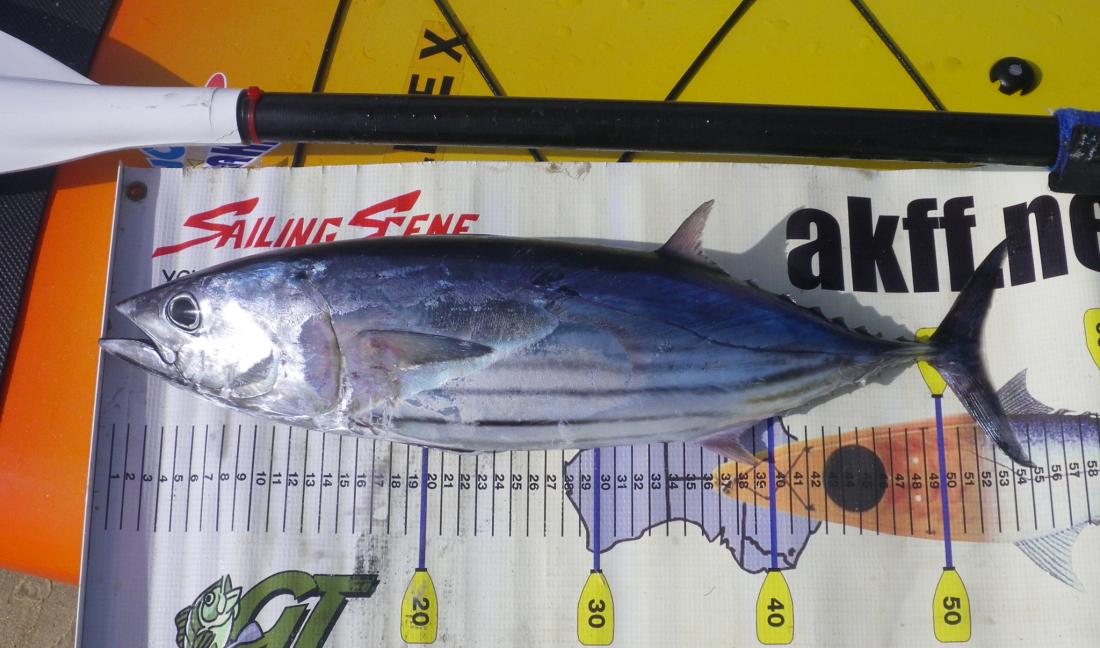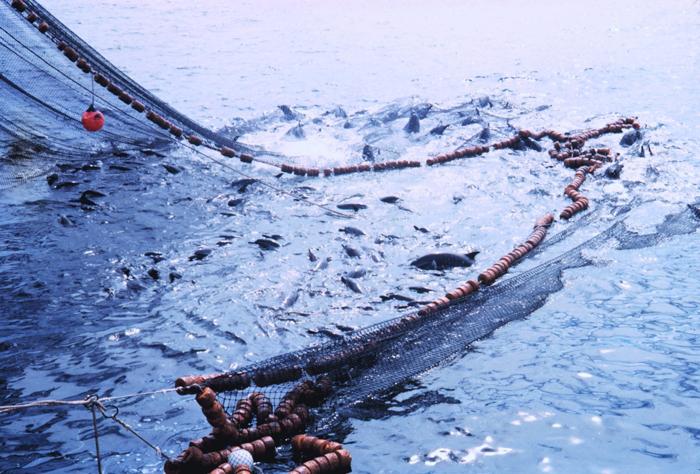Pacific Skipjack Tuna
Katsuwonus pelamis
The Science
THE SCIENCE
Skipjack Tuna has a high metabolism, and can eat up to 25% of its bodyweight a day! [4]

Taxonomic description
- Has a silver body, with a dark blue-black back, and four to six dark stripes along its sides. [2,4]
- Has very few scales, except for along its lateral line and head. [4]
Distribution
- Found throughout Pacific, Atlantic, and Indian Oceans in tropical and subtropical waters. [1,2,4]
- Highly migratory. [1,2,4]
Life history
- Has a life span of 7-12 years. [1]
-
Matures around 1 year of age and around 39.6 cm (1.3 ft) long, and it can grow up to 1.2 m (4 ft) and weigh over 70 pounds. [4,6,7]
- Spawns all year long in equatorial waters and females can lay up to two million eggs. [1,2]
- Through broadcast spawning, released eggs are fertilized and hatch one day later. [7]
- Often found in schools of thousands for hunting and reproduction. [3]
Habitat
- Lives in the pelagic zone, spending most of its life in the open ocean. [7]
- Schools with bigeye and yellowfin tuna. [7]
- Predators of skipjack tuna includes large pelagic fishes, including billfish, larger tunas, and sharks. [6,7]
- Preys on other fish, crustaceans, mollusks, and other tunas. [4,6,7]
The Fishery
THE FISHERY
Making up at least 60% of legally caught tunas, Skipjack is the most heavily fished tuna worldwide. [3]

Seasonal availability
- Available year round. [5]
Regulatory and managing authority
- Internationally overseen by the Inter-American Tropical Tuna Commission (IATTC) and the Western and Central Pacific Fisheries Commission (WCPFC). [5,6]
- Along the Pacific West Coast, the fishery is overseen by NOAA fisheries and, as established by the Magnuson-Stevens Act, the Pacific Fishery Management Council through the West Coast Highly Migratory Species Fisheries Management Plan. [5]
- As established by the Marine Life Management Act, the California Department of Fish and Wildlife (CDFW) collects data on this fishery through the Pelagic Fisheries and Ecosystems Program. [10,11]
Gear type
- Gear used include purse seines, troll, artisanal handline, pelagic longline, pelagic hook-and-line, and pole-and-line. [4,5,7]
- Purse seines are predominantly used. [5]
Status of the fishery
- Skipjack populations are difficult to assess due to high and variable productivity, but populations are thought to be stable and not overfished or subject to overfishing as of a 2015 stock assessment. [5,7]
- Rapid growth and reproduction rates help tuna resist fishing pressure. [7]
- The Fishery Management Plan for U.S. West Coast fisheries for Highly Migratory Species management includes:
- Permits and documentation of catch. [5]
- Gear constraints and requirements for operation. [5]
- Large vessels require observer coverage and other vessels are subject to observer requests by NOAA. [5]
- Measures have been adopted from the WCPFC and IATTC to regulate catch of juvenile tuna effecting other species through use of purse seine. [5]
Potential ecosystem impacts
- When large purse-seine nets are set around Fish-Aggregation-Devices, there is a substantial amount of bycatch, including: other fish, sharks, rays, and sometimes even sea turtles, whales, or dolphins. [2,5,7,9]
- Because fishing gears used for these tuna typically do not touch the ocean floor, there is minimal impact on the surrounding habitat. [6,7]
The Seafood
THE SEAFOOD
The canned tuna market is by far the most frequent production, with over 95% of skipjack tuna contributing to canned tuna supply. [4]


Edible portions
-
Steaks, loins, headed and gutted, and canned. [7]
Description of meat
- Deep red when raw, light gray when cooked. [5,7]
- Large flakes of firm, moist, mild meat. [5,7]
- Skipjack tuna has the most pronounced taste of tropical tunas. [5,7]
Culinary uses
- Can be made fresh or frozen as steaks, loins, or headed and gutted. [7]
- Typically fried, broiled, or sautéed. [7]
- Most often eaten as canned, as “canned light” or “chunk light” tuna. [4,7]
- For a tuna cake recipe, visit Martha Stewart. [12]
- For a Filipino tuna recipe, visit Panlasang Pinoy. [13]
Nutritional information
- Tuna is a great source of low-fat protein. [7]
- It has significant levels of omega-3 that benefit health in multiple ways. [1]
- Nutrition facts given for a 100g serving. [5]
Toxicity report
- Canned light tuna has a moderate concentration of mercury, but is a safer choice compared to other canned tuna. [8]
Seasonal availability
- Available year round. [5]
References
[1] AnimalSpot. 2018. Skipjack Tuna. Webhttp://www.animalspot.net/skipjack-tuna.html. Accessed: 31 October 2018
[2] WWF. 2017. Skipjack Tuna. Web. https://www.worldwildlife.org/species/skipjack-tuna. Accessed: 31 October 2018
[3] Oceana. Skipjack Tuna. Web. https://oceana.org/marine-life/ocean-fishes/skipjack-tuna. Accessed: 31 October 2018
[4] This Fish. 2013. Species: Skipjack Tuna. Web. https://thisfish.info/fishery/species/skipjack-tuna/. Accessed: 1 November 2018
[5] FishWatch. 2018. Pacific Skipjack Tuna. Web. https://www.fishwatch.gov/profiles/pacific-skipjack-tuna. Accessed: 1 November 2018
[6] NOAA Fiseries. Pacific Skipjack Tuna. Web. https://www.fisheries.noaa.gov/species/pacific-skipjack-tuna. Accessed: 1 November 2018
[7] FishChoice. Skipjack Tuna. Web. https://fishchoice.com/buying-guide/skipjack-tuna. Accessed: 1 November 2018
[8] Environmental Defense Fund. 2018. Mercury alert: Is canned tuna safe?. Web. https://www.edf.org/oceans/mercury-alert-canned-tuna-safe . Accessed: 5 November 2018
[9] GreenPeace. 2014. If You Eat Tuna, You Should Know These Five Fish. Web. https://www.greenpeace.org/usa/eat-tuna-know-fish/. Accessed: 5 November 2018
[10] Marine Life Management Act. n.d. California Department of Fish and Wildlife. Web. https://wildlife.ca.gov/Conservation/Marine/MLMA. Accessed 24 August 2020.
[11] Overview of the Pelagic Fisheries and Ecosystems Program. n.d. California Department of Fish and Wildlife. Web. https://wildlife.ca.gov/Conservation/Marine/Pelagic#52132542-overview. Accessed 9 December 2020.
[12] Stewart, M. Martha Stewart. 2007. Tuna Cakes Recipe. Web. https://www.marthastewart.com/332237/tuna-cakes. Accessed 19 January 2021.
[13] Manny. Panlasang Pinoy. 2018. Adobong Tulingan Recipe. Web. https://www.panlasangpinoymeatrecipes.com/adobong-tulingan-skipjack-tun…. Accessed 19 January 2021.
[14] Duffy, C. iNaturalist. 2019. Digital image. Web. https://www.inaturalist.org/photos/31259311. Accessed 22 February 2021.
[15] Long, K. iNaturalist. 2014. Digital image. Web. https://www.inaturalist.org/photos/13975156. Accessed 23 February 2021.
[16] Kasman, A. flickr. 2014. Smoked skipjack tuna #2. Digital image. Web. https://flickr.com/photos/hiddenpark/12401529984. Accessed 22 February 2021.



